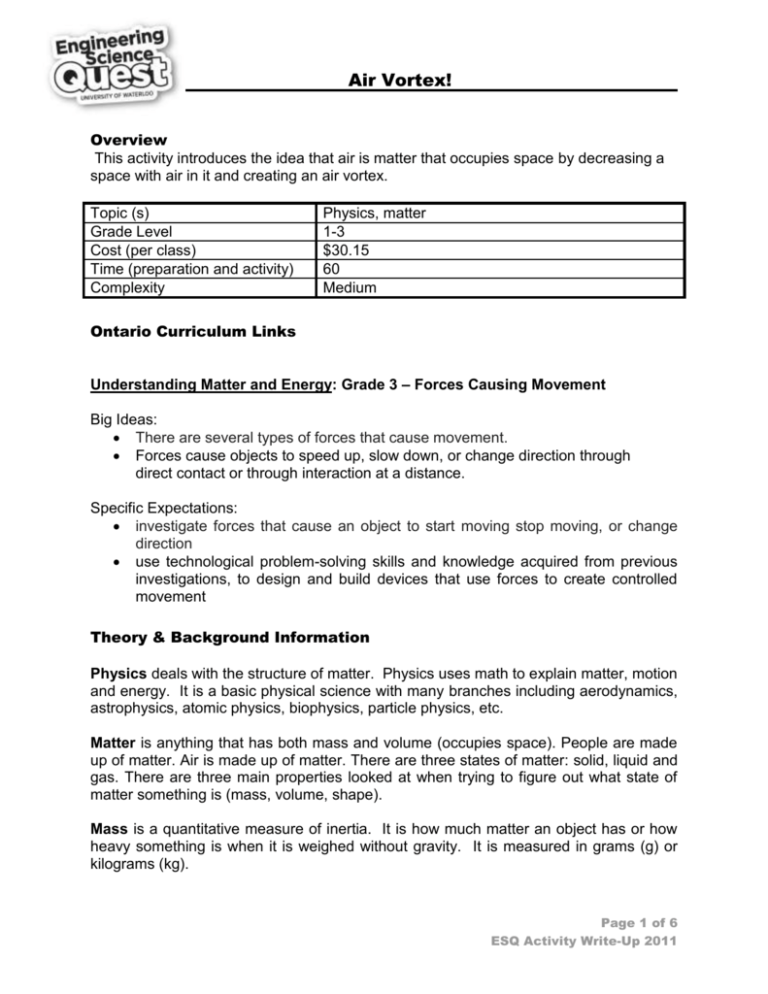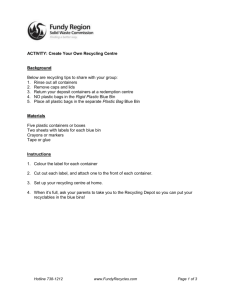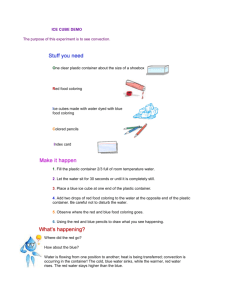Overview
advertisement

Air Vortex! Overview This activity introduces the idea that air is matter that occupies space by decreasing a space with air in it and creating an air vortex. Topic (s) Grade Level Cost (per class) Time (preparation and activity) Complexity Physics, matter 1-3 $30.15 60 Medium Ontario Curriculum Links Understanding Matter and Energy: Grade 3 – Forces Causing Movement Big Ideas: There are several types of forces that cause movement. Forces cause objects to speed up, slow down, or change direction through direct contact or through interaction at a distance. Specific Expectations: investigate forces that cause an object to start moving stop moving, or change direction use technological problem-solving skills and knowledge acquired from previous investigations, to design and build devices that use forces to create controlled movement Theory & Background Information Physics deals with the structure of matter. Physics uses math to explain matter, motion and energy. It is a basic physical science with many branches including aerodynamics, astrophysics, atomic physics, biophysics, particle physics, etc. Matter is anything that has both mass and volume (occupies space). People are made up of matter. Air is made up of matter. There are three states of matter: solid, liquid and gas. There are three main properties looked at when trying to figure out what state of matter something is (mass, volume, shape). Mass is a quantitative measure of inertia. It is how much matter an object has or how heavy something is when it is weighed without gravity. It is measured in grams (g) or kilograms (kg). Page 1 of 6 ESQ Activity Write-Up 2011 Air Vortex! Volume is a quantitative measure of how much three dimensional space matter occupies. Shape is the external surface or form of an object All solids have a definite shape, mass and volume. All liquids have a definite mass and volume but do not have a definite shape. All gases do not have a definite shape, mass or volume. Air Vortex is an area of rotating air that takes on a doughnut shape when travelling though air. It can travel long distances. This occurs in a nature when warm humid air rises rapidly and will start to form a tornado. How the Air Vortex works Air occupies space. It occupies the space within the air vortex. When the plastic sheet is pulled back, the volume of the air increases while the pressure decreases. As the plastic sheet is let go and pushed into the container, the volume decreases and pressure increases. The increase in pressure forces some of the air out of the hole. The velocity of the air as it leaves the bucket depends on the size of the hole it’s leaving through; the smaller the hole, the greater the velocity of the air. The ‘ball’ of air that shoots out of the cannon is actually a flat vortex of air. Materials Per Camper: 1 small plastic flower pot or yogurt container 1 plastic grocery bag (can be shared with a 2 of campers) Duct tape 3 Elastic bands (approximately 5mm wide and 7cm long) 1 big paper clip Scissors/ exacto knife Water bottle half filled with water 1 Penny Procedure Preparations 1. Gather necessary materials 2. Pre cut holes in flower pots or yogurt containers (holes are approximately 5 cm wide and are located in the middle of the bottom of the container) 3. Cut lengths of plastic bags for each camper (at least 30cm x 30cm) 4. Cut lengths of duct tape for each camper 5. Half fill water bottle with water and place a penny inside Introduction Page 2 of 6 ESQ Activity Write-Up 2011 Air Vortex! 1. Introduce the topic of physics. Explain that there are many branches of physics but all use math to explain matter, motion and energy. 2. Explain what matter is. Matter is anything that has both mass and volume (occupies space). People are made up of matter. Air is made up of matter. a. How many states of matter are there? (3) b. What are these three states? (Solid, Liquid, Gas) c. How can you tell something is a solid, liquid or gas? (let them just brainstorm ideas, you will explain it later on) d. What are some examples of a solid? (desk) e. What are some examples of a liquid? (water) f. What are some examples of a gas? (oxygen) 3. Talk about the three main properties shape, volume and mass. a. Mass is a quantitative measure of inertia. It is how much matter an object has or how heavy something is when it is weighed without gravity. It is measured in grams (g) or kilograms (kg). b. Volume is a quantitative measure of how much three dimensional space matter occupies. c. Shape is the external surface or form of an object 4. Now that you know the main properties used to define a solid liquid and gas, can anyone describe one of the states using these terms? (All solids have a definite shape, mass and volume. All liquids have a definite mass and volume but do not have a definite shape. All gases do not have a definite shape, mass or volume.) 5. Explain the concept of pressure and the volume of gas while using a half filled water bottle and a penny as a demonstration a. Show the water bottle and explain i. The penny is a solid and has a definite mass, shape, and volume ii. The water is a liquid and has a definite mass, and volume but not a defiant shape iii. The air does not have a definite mass, volume or shape b. Explain why this is and do different things with the bottle (like squeeze it) to explore the different properties of each state of matter. 6. Now explain the concept of the Airzoooka a. Air occupies the space within the Air Vortex. When the plastic sheet is pulled back, the volume of the air increases while the pressure decreases. As the plastic sheet is let go and pushed into the container, the volume decreases and pressure increases. The increase in pressure forces some of the air out of the hole. The velocity of the air as is leaves the bucket depends on the size of the hole it’s leaving through; the smaller the hole, the greater the velocity of the air. This creates a vortex of air. Activity Page 3 of 6 ESQ Activity Write-Up 2011 Air Vortex! 1. Cut a hole in the center of the bottom of the plastic container. Hole should be smaller than bottom of the container. Plastic Container Hole 2. Cut two slits near the edges of the container directly across from each other (see diagram below). 3. Feed an elastic band though each of the slits and duct tape the ends so that the elastic band is dangling inside the container. Slit Duct Tape Elastic Band 4. Cut out a sheet of plastic bag big enough to cover more than enough of the top of the container (opposite side of the cut out hole). 5. Lay out the plastic sheet and duct tape a cross on both sides of the sheet (in the middle). This is so that the bag is stronger at the pulling point. Plastic Bag Duct Tape Page 4 of 6 ESQ Activity Write-Up 2011 Air Vortex! 6. Poke two holes at the center of the duct tape cross and feed a big paper clip (that is unwound) through the holes. Make sure that the pointy ends are facing out one side and there’s a tiny paper clip loop on the other side. Plastic Sheet Duct Tape Paper Clip 7. Feed the last elastic band through the two other elastic band loops and attach the free ends of the last elastic to the paper clip. You can attach the free ends by looping them to the paper clip and then twisting the paper clip. Slit Elastic 1 Elastic 2 Elastic 3 Paper Clip Plastic Sheet 8. Now duct tape the rest of the plastic bag to the sides of the container. Make sure that everything is even and that the cross is right in the middle of the container. Activity Accommodations and Extensions Accommodations Page 5 of 6 ESQ Activity Write-Up 2011 Air Vortex! Pre- cut the hole in the flower pot and precut and the plastic bags. Also, assist with getting elastic bands positioned correctly Extensions Set up a competition to see who’s can shoot the farthest by knocking over paper cups or blowing out a candle. Safety Considerations Make sure kids are careful when using scissors Resources http://exchange.actua.ca http://www.stevespanglerscience.com/experiment/00000076 http://www.instructables.com/id/ECXNI9BMKMEZTBBVU8/ http://www.britannica.com/EBchecked/topic/458757/physics Page 6 of 6 ESQ Activity Write-Up 2011






